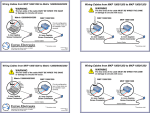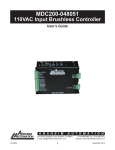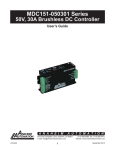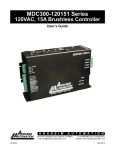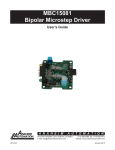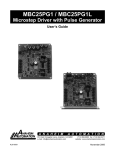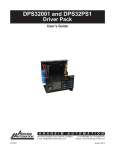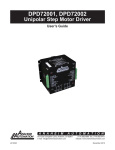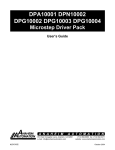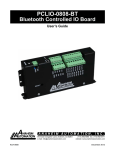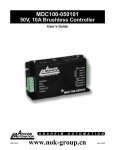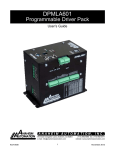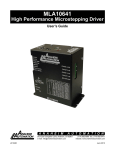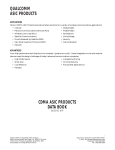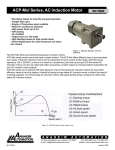Download MDC151-024031 Series Users Guide
Transcript
MDC151-024031 Series 24V, 3A Brushless DC Controller User’s Guide A N A H E I M A U T O M A T I O N 910 East Orangefair Lane, Anaheim, CA 92801 e-mail: [email protected] L011077 1 (714) 992-6990 fax: (714) 992-0471 website: www.anaheimautomation.com July 2013 MDC151-024031 Driver Features • • • • • • • • • • • • Fixed Current Limit Setting 3.0 Amps 0V to 5V External Voltage Speed Control 2-Quadrant Operation Hall Sensor Feedback Constant Velocity Mode Short Circuit Protection Requires 10 - 24VDC Speed Out Run/Stop, Freewheel and Direction TTL-CMOS Compatible Inputs Compact Size Open Frame General Description The MDC151-024031 driver is designed to drive DC brushless motors at currents of up to 3A (peak) and 24V. Using hall sensor feedback, a constant velocity mode is set. The driver is protected against over current (cycle-by-cycle), hall sensor error and under voltage. When an error occurs, a fault light is turned on to notify the user. An external voltage (0-5VDC) can be used to control the speed. The direction of the motor can be preset by the direction control input. Other inputs to the drive include a run/stop and a motor freewheel input. Fault Protection If a motor current level exceeding the current limit set, an over current latch is activated, shutting off the output. This driver is equipped with a FAULT LED to alert the user of the following conditions. 1. Invalid Sensor Input Code 2. Over Current. The driver is equipped with cycle-by-cycle current limiting or over current latch. 3. Undervoltage Lockout activation at 9.1VDC for the input voltage and 4.5VDC for Hall Sensor voltage. Power Supply/Ordering Information Ordering Information Part Number MDC151-024031 MDC151-024031-TB L011077 Description 10-24VDC, 3A Brushless Controller, Closed loop, Open-Frame 10-24VDC, 3A Brushless Controller, Closed loop, Open-Frame with detachable terminal blocks PS-35-24 DC Power Supply 24VDC at 1.5 Amps PSA24V2.7A DC Power Supply 24VDC at 2.7 Amps CBL-AA4031 7 Pin Input Connector with 12”, 22AWG Leads CBL-AA6131 8 Pin Motor Connector with 12”, 22AWG Leads CON-6404407 7 Pin Connector with 0.100” Centers (Amp #640440-7) CON-6404408 8 Pin Connector with 0.100” Centers (Amp #640440-8) 2 July 2013 Specifications Control Inputs:(P1, Pins 3-5) TTL-CMOS Compatible Logic “0” = 0-0.8VDC Logic “1” = OPEN All three inputs (run/stop, direction, and freewheel) are pulled up to 40k ohm resistors. Run/Stop: (P1, Pin 3) Logic “1” (open) - Motor will not run and if running will come to a hard stop Logic “0” - Motor will run Direction Control: (P1, Pin 4) Logic “1” (open) - Clockwise Logic “0” - Counterclockwise Freewheel: (P1, Pin 5) Logic “1” (open) - Motor is Enabled Logic “0” - Motor is de-energized and will coast Vcontrol: (P1, Pin 6) To control the speed of the motor with an external DC voltage, 0VDC (min) - 5VDC (max) Speed Output (PGout): (P1, Pin 7) An open drain pulse output has a max rating of 30VDC/50mA. 8-pole motor RPM = 15 * PG OUT (in Hz) 6-pole motor RPM = 20 * PG OUT (in Hz) 4-pole motor RPM = 30 * PG OUT (in Hz) Output Current Rating: 3.0 amperes per phase maximum operating peak current (1.5 amperes per phase maximum operating continuous current) Power Requirements: (P1, Pins 1 and 2) 10VDC (min) - 24VDC (max) Operating Temperature: Board: 0°-70° C L011077 3 July 2013 Hall Sensor Power Output: 6.25V @ 30mA maximum. Typical current draw from hall sensor is 20mA. All three Hall Sensor inputs are pulled up through 20K ohm resistors. Closed Loop (Constant Velocity Mode) The driver is set for Closed Loop operation. Closed Loop operation is used for applications where speed regulation is needed. Under closed loop operation, the speed is regulated despite changes to the load. If using an Anaheim Automation DC Brushless motor, the tables shown on the next page are the Close Loop potentiometer and jumper settings for each motor. The regulated speed of the motor is then controlled by adjusting external speed input. The motor speed can be monitored by measuring the pulse rate of PG OUT (P1 - pin 7). If using a non-Anaheim Automation DC Brushless Motor. 1. Start with setting the jumpers on pins 1 and 2. 2. Set CL Adjust Pot to 50%. 3. Adjust the external speed input to 5V. 4. Decrease the closed loop gain by turning the pot CCW until the motor speed decreases to the maximum speed. If the rated speed does not change or cannot be varied, switch the jumpers to pin 2 and 3. Anaheim Automation Motor Closed Loop Settings 4-Pole Motors 8-Pole Motors Motor JP1 CL POT MAX SPD (RPM) BLWR092S-24V-4600 1-2 75% 4600 BLWR110S-15V-8000 1-2 75% 8000 BLWR111S-12V-15000 1-2 75% 15000 BLWR111S-24V-10000 1-2 75% 10000 BLWR112S-24V-3700 1-2 25% 3700 BLWR112S-36V-10000* 1-2 75% 7500 BLWR132S-24V-4000 1-2 25% 4000 BLWR231S-36V-4000* 1-2 25% 3000 BLWR231S-24V-11000 1-2 75% 11000 BLWS231S-24V-2000 2-3 75% 2000 BLWS232S-24V-1350 2-3 75% 1350 BLWS233D-24V-4000 BLWS233S-24V-4000 1-2 25% 4000 Motor JP1 CL POT MAX SPD (RPM) BLY171S-17V-8000 1-2 75% 8000 BLY172S-17V-9500 1-2 75% 9500 BLY171S-24V-4000 1-2 75% 4000 BLY172D-24V-4000 BLY172S-24V-4000 1-2 75% 4000 BLY173D-24V-4000 BLY173S-24V-4000 1-2 75% 4000 BLY174D-24V-4000 BLY174S-24V-4000 1-2 75% 4000 BLY171S-12V-200 2-3 25% 200 BLY171S-15V-8000 1-2 75% 8000 BLY171S-17V-8000 1-2 75% 8000 BLY172D-12V-230 2-3 25% 230 BLY174D-24V-12000 1-2 75% 12000 BLY172S-12V-500 2-3 100% 500 *Note: 36V motors ran at 24VDC. Speed is set to run at 75% of rated value. L011077 4 July 2013 Commutation Sequence Step 1 2 Phase A + Z Phase B Z + Phase C - - Hall A 1 Hall B Hall C 3 Step 4 5 6 1 2 3 - - Z + + Z - - Z + + 1 0 0 0 1 1 0 0 0 Phase A - Z Phase B Z - Z Phase C + 0 1 Hall A 1 0 0 1 1 1 120° Hall Spacing Sequence Forward 4 5 6 + + Z - - Z + + + Z - - Z 1 1 0 0 0 1 Hall B 0 1 1 1 0 0 Hall C 0 0 0 1 1 1 120° Hall Spacing Sequence Reverse Step Step 1 2 3 4 5 6 1 2 3 4 5 6 Phase A + Z - - Z + Phase A - Z + + Z - Phase B Z + + Z - Phase C - - Z + + - Phase B Z - - Z + + Z Phase C + + Z - - Z Hall A 1 1 1 0 0 0 Hall A 1 1 1 0 0 0 Hall B 0 1 1 1 0 0 Hall B 0 1 1 1 0 0 Hall C 0 0 1 1 1 0 Hall C 0 0 1 1 1 0 60° Hall Spacing Sequence Forward 60° Hall Spacing Sequence Reverse + = Top Transistor ON, Bottom Transistor OFF, Current Flows into this wire - = Top Transistor OFF, Bottom Transistor ON, Current Flows out of this wire Z = Top Transistor OFF, Bottom Transistor OFF, No current into or out of this wire (High Impedance) Motor Connection Refer to the hookup diagram for typical driver applications. When connecting a motor for the first time, connect the hall sensor wires (5 of them) to the driver. DO NOT CONNECT THE PHASES YET. Turn on power and rotate the motor by hand. If the RED FAULT LED comes on, the hall phases are incorrectly wired. If the RED FAULT LED does not come on then the hall wires are connected correctly. Power the unit down and proceed to connect the motor phases. If the motor does not run or runs erratically, power down and check the speed potentiometer and make sure the phases are connected correctly. There are six different ways to connect the phase wires, and normally only two will allow the motor to rotate, but only one is correct. If the direction of the motor is changed and the no-load current of the motor is approximately the same and the motor runs smoothly in both directions then the phase wires are correct. The wiring of the motor phases should be separated from the hall and input connections to not allow a possible source of interference. L011077 5 July 2013 Connecting to the MDC151-024031 The MDC151-024031 is designed with cost savings and size as two of the primary design criteria. For this reason, the MTA-100 series connector was chosen for these products as a reliable small and low cost connector. This is a common Insulation Displacement Connector (IDC) manufactured by AMP Corporation. The inputs to the driver are on a 7-pin connector and the motors are on a 8-pin connector. These connectors are not supplied with the driver, but can be purchased from Anaheim Automation or AMP/Tyco Electronics. The two images below show how a hand tool can be used to quickly make the cable to connect to the driver. This cable can be made in approximately 10 seconds per wire using the hand tool. Tooling from AMP/Tyco Electronics Part Number Description 58074-1 Manual Hand Tool with Interchangeable Head (shown above) 58075-1 Air Hand Tool with Interchangeable Head 58338-1 Air Bench Mount Tool with Interchangeable Head and Foot Switch 58246-1 Die Head for Closed End MTA-100 Connectors (shown above) Tooling from AMP/Tyco Electronics Part Number L011077 Description 640440-7 7 Pin MTA-100 Connector, Closed End with Lock, 22 AWG Red, Tin Plated 640440-8 8 Pin MTA-100 Connector, Closed End with Lock, 22 AWG Red, Tin Plated 640441-7 7 Pin MTA-100 Connector, Closed End with Lock, 24 AWG White, Tin Plate 640441-8 8 Pin MTA-100 Connector, Closed End with Lock, 24 AWG White, Tin Plated 640442-7 7 Pin MTA-100 Connector, Closed End with Lock, 26 AWG Blue, Tin Plated 640442-8 8 Pin MTA-100 Connector, Closed End with Lock, 26 AWG Blue, Tin Plated 6 July 2013 Terminal Descriptions Pin # Description Pin # Description 1 VIN (10-24VDC) 1 Phase A 2 GND 2 Phase B 3 Run/Stop 3 Phase C 4 Direction 4 Hall Sensor Power 5 Freewheel 5 Hall Sensor A 6 VControl 6 Hall Sensor B 7 PGout 7 Hall Sensor C 8 Hall Sensor Ground P1: Power, Control Inputs and Outputs P2: Motor Hall Terminals and Motor Phase Terminals Motor Freewheel The motor freewheel feature allows the de-energizing of the motor phases. A high (open) input at this input causes the motor to run at the given speed, while a low at this input causes the motor to coast to a stop. Motor Run/Stop The motor run/stop feature allows the stopping of a motor by shorting out the bottom drives of the three phases. A low at this input allows the motor to run, while a high (open) input does not allow motor operation and if operating causes rapid deceleration. Motor Direction The motor direction feature allows the changing of the rotation of the motor. This input should not be changed while motion is in progress. A high (open) input causes the motor to turn in the CW direction, while a low at this input causes the motor to turn in the CCW direction. Note: Avoid changing the direction of rotation when the motor is already running any one direction. The following instructions must be followed to prevent permanent drive failure due to over-current conditions that exist in dynamic direction reversals of the motor: 1. Stop the motor by grounding the RUN/STOP input 2. Wait for at least 500mS 3. Change the direction with the DIRECTION input 4. Run the motor by removing ground signal on the RUN/STOP input Speed Adjust Setting The speed may be varied at Vcontrol from 0V-5V maximum. If a voltage other than 0V to 5V is needed to control the speed of the motor, contact Anaheim Automation for custom tuning of the Vcontrol input. L011077 7 July 2013 Speed Output The PG OUT terminal (P1 - pin 7) is used to determine the speed of the motor shaft. An open drain output is shown at a rate of 4 pulses for 1 revolution of an 8-pole motor, 3 pulses for 1 revolution of a 6-pole motor, and 2 pulses for 1 revolution of a 4-pole motor. Max rating of 30VDC/50mA. # Poles RPM 8 15 * PG OUT (in Hz) 6 20 * PG OUT (in Hz) 4 30 * PG OUT (in Hz) Heating Considerations The temperature of the board should never be allowed to rise above 70° Celsius. If necessary, air should be blown across the heat sink to maintain suitable temperatures. Torque Curves BLWR132S-24V-4000 with MDC151-024031, 24VDC 4200 2 Torque-Speed Torque-Current 4000 3600 1 Current (Amp) RPM 3800 3400 3200 3000 0 1 2 3 4 5 6 7 0 Torque (oz-in) L011077 8 July 2013 Typical Wiring Diagram Dimensions MDC151-024031TB MDC151-024031 *All units in inches L011077 9 July 2013 COPYRIGHT Copyright 2013 by Anaheim Automation. All rights reserved. No part of this publication may be reproduced, transmitted, transcribed, stored in a retrieval system, or translated into any language, in any form or by any means, electronic, mechanical, magnetic, optical, chemical, manual, or otherwise, without the prior written permission of Anaheim Automation, 910 E. Orangefair Lane, Anaheim, CA 92801. DISCLAIMER Though every effort has been made to supply complete and accurate information in this manual, the contents are subject to change without notice or obligation to inform the buyer. In no event will Anaheim Automation be liable for direct, indirect, special, incidental, or consequential damages arising out of the use or inability to use the product or documentation. Anaheim Automation’s general policy does not recommend the use of its’ products in life support applications wherein a failure or malfunction of the product may directly threaten life or injury. Per Anaheim Automation’s Terms and Conditions, the user of Anaheim Automation products in life support applications assumes all risks of such use and indemnifies Anaheim Automation against all damages. LIMITED WARRANTY All Anaheim Automation products are warranted against defects in workmanship, materials and construction, when used under Normal Operating Conditions and when used in accordance with specifications. This warranty shall be in effect for a period of twelve months from the date of purchase or eighteen months from the date of manufacture, whichever comes first. Warranty provisions may be voided if products are subjected to physical modifications, damage, abuse, or misuse. Anaheim Automation will repair or replace at its’ option, any product which has been found to be defective and is within the warranty period, provided that the item is shipped freight prepaid, with previous authorization (RMA#) to Anaheim Automation’s plant in Anaheim, California. TECHNICAL SUPPORT If you should require technical support or if you have problems using any of the equipment covered by this manual, please read the manual completely to see if it will answer the questions you have. If you need assistance beyond what this manual can provide, contact your Local Distributor where you purchased the unit, or contact the factory direct. ANAHEIM AUTOMATION L011077 10 July 2013










